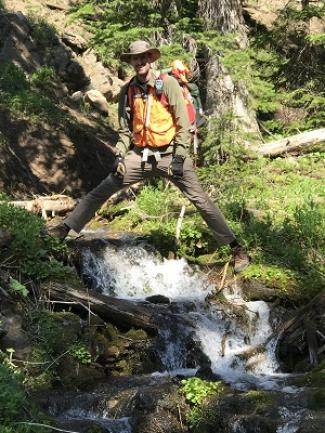CU Denver Dept. of Integrative Biology
Graduate Student Thesis Defense
We are pleased to announce that Michael's thesis defense was a success! Congratulations Michael!
Michael Kain
Integrative Biology M.S. Candidate in Dr. Annika Mosier’s Lab
WHEN: Thursday, Dec. 2, 2021 at Noon
WHERE: Seminar will be presented via Zoom
Zoom Meeting: Please email Jacki Craig for the Zoom Link Information but preferably before 11:45p on the day of the defense.
Differentiation of Soil Status and Microbial Community Structure 30 Years After Severe Forest Fire
Fires impart both structural and functional changes to below ground forest ecosystems. Fire exerts direct pressures through combustion and thermal stress and indirect pressures through changes in pools of organic/inorganic resources as well as in alterations to the soil microbiome. Both direct and indirect pressures drive changes in recovery trajectories and long-term function. Here, we investigate the recovery state of the soil microbial community in a former subalpine forest 30 years after severe forest fire at two study sites in the Greater Yellowstone Ecosystem (Mount Washburn and Henderson Mountain). Soil chemistry and microbial community structure were evaluated across conditional and spatial dimensions to evaluate the impact of burn status and physical location on differences in membership. Soil nitrogen and organic carbon showed differences between burned and unburned samples at both mountains. Weighted UniFrac distance showed that the microbial community structure at Henderson and Washburn burned plots formed a coherent group clustering near other burned samples. Microbial communities from burned plots were similar to each other regardless of study area. A total of 722 ASVs were found exclusively at burned plots belonging belonged predominantly to Haliangium, Gemmatimonas, Ellin6067, and Conexibacter genera. Microbial community structure from the unburned plots largely clustered together, but many of the samples also overlapped with the burned plots. A total of 455 ASVs belonging to 19 distinct phyla and 90 distinct genera were found only at unburned plots. Nearly 30% of the ASVs were present at all site types (Henderson/Washburn, Burned/Unburned), making up the core microbial community that likely plays key roles in soil biogeochemistry across the ecosystem. Overall, it appears that burn status and soil nitrogen and carbon play an important role in shaping microbial community structure. This systematic study of the conditions in the soil 30 years after a significant disturbance provides valuable insight into the divergent conditions at both study sites and burn conditions. Ultimately, our findings will help inform future studies aimed at understanding the long-term consequences of wildfires in similar ecosystems.
Everyone is welcome to join the seminar, please see the Zoom link information above.

